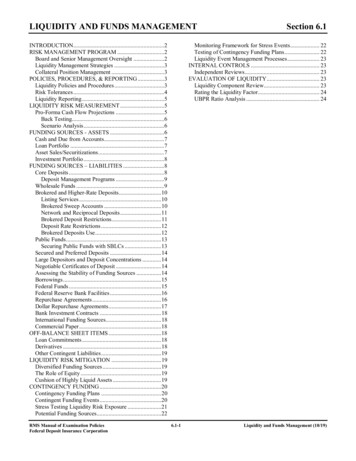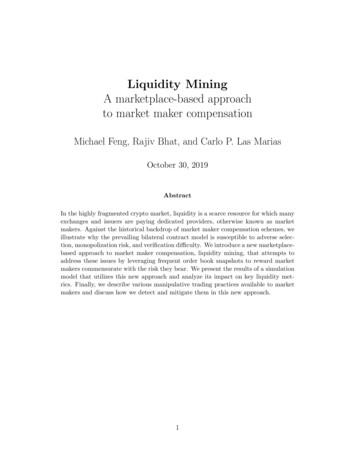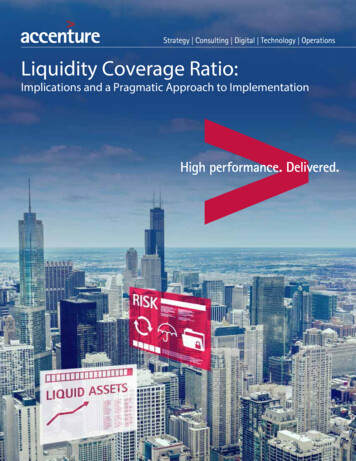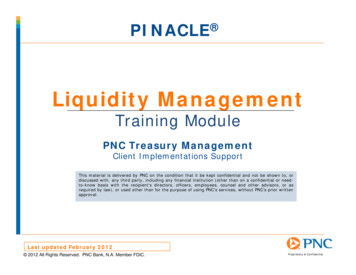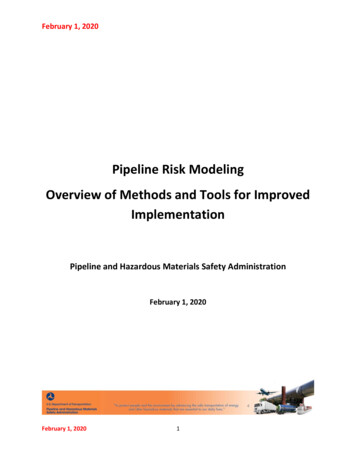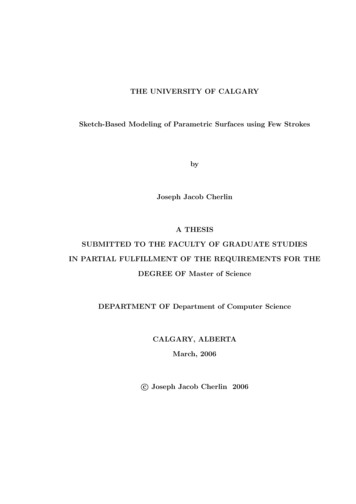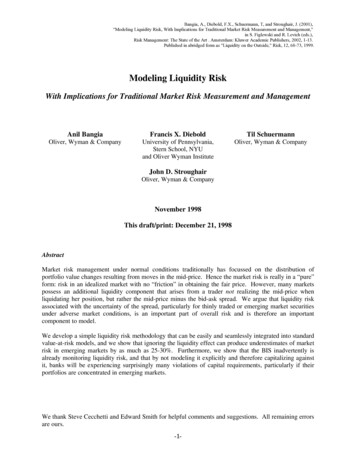
Transcription
Bangia, A., Diebold, F.X., Schuermann, T, and Stroughair, J. (2001),"Modeling Liquidity Risk, With Implications for Traditional Market Risk Measurement and Management,"in S. Figlewski and R. Levich (eds.),Risk Management: The State of the Art . Amsterdam: Kluwer Academic Publishers, 2002, 1-13.Published in abridged form as "Liquidity on the Outside," Risk, 12, 68-73, 1999.Modeling Liquidity RiskWith Implications for Traditional Market Risk Measurement and ManagementAnil BangiaFrancis X. DieboldTil SchuermannOliver, Wyman & CompanyUniversity of Pennsylvania,Stern School, NYUand Oliver Wyman InstituteOliver, Wyman & CompanyJohn D. StroughairOliver, Wyman & CompanyNovember 1998This draft/print: December 21, 1998AbstractMarket risk management under normal conditions traditionally has focussed on the distribution ofportfolio value changes resulting from moves in the mid-price. Hence the market risk is really in a “pure”form: risk in an idealized market with no “friction” in obtaining the fair price. However, many marketspossess an additional liquidity component that arises from a trader not realizing the mid-price whenliquidating her position, but rather the mid-price minus the bid-ask spread. We argue that liquidity riskassociated with the uncertainty of the spread, particularly for thinly traded or emerging market securitiesunder adverse market conditions, is an important part of overall risk and is therefore an importantcomponent to model.We develop a simple liquidity risk methodology that can be easily and seamlessly integrated into standardvalue-at-risk models, and we show that ignoring the liquidity effect can produce underestimates of marketrisk in emerging markets by as much as 25-30%. Furthermore, we show that the BIS inadvertently isalready monitoring liquidity risk, and that by not modeling it explicitly and therefore capitalizing againstit, banks will be experiencing surprisingly many violations of capital requirements, particularly if theirportfolios are concentrated in emerging markets.We thank Steve Cecchetti and Edward Smith for helpful comments and suggestions. All remaining errorsare ours.-1-
“Portfolios are usually marked to market at the middle of the bid-offer spread,and many hedge funds used models that incorporated this assumption. In lateAugust, there was only one realistic value for the portfolio: the bid price.Amid such massive sell-offs, only the first seller obtains a reasonable price forits security; the rest loose a fortune by having to pay a liquidity premiumif they want a sale. Models should be revised to include bid-offer behaviour.”Nicholas Dunbar (“Meriwether’s Meltdown,” Risk, October 1998, 32-36)I. INTRODUCTIONThe recent turmoil in the capital markets has led experts and laymen alike to cast liquidity risk in the roleof the culprit. Inexperienced and sophisticated players were all caught by surprise when markets dried up.Unsurprisingly, the first to go were the emerging markets in Asia and more recently in Russia. Then itspilled over into the US corporate debt market which was indeed much more surprising. Its most famousvictim has been Long Term Capital Management (LTCM). Spreads appeared to widen out of the blue;but this could have been predicted.More generally, it is a well acknowledged fact that the standard Value-at-Risk (VaR) concept used formeasuring both market and credit risk for tradable securities lacks a rigorous treatment of liquidity risk.At best, the risk for large illiquid positions is adjusted upwards in an ad hoc fashion by utilizing a longertime horizon in the calculation of VaR that at best is a subjective estimate of the likely liquidation time ofthe position. This holding-period adjustment is usually carried out using the square root of time scalingof the variances and covariances rather than a recalculation of variances and covariances for the longertime horizon.1However, the combination of the recent rapid expansion of emerging market trading activities and therecurring turbulence in those markets has propelled liquidity risk to the forefront of market riskmanagement research. New work in asset pricing has demonstrated how liquidity plays a key role insecurity valuation and optimal portfolio choice by effectively imposing endogenous borrowing and shortselling constraints, as argued by Longstaff (1998) and the references therein. Liquidity also plays a majorrole in transaction costs as trades of large illiquid positions typically execute at a price away from themid-price. BARRA’s Market Impact Model and other such models quantify the market impact cost,defined as the cost of immediate execution, for establishing and liquidating large positions. Jarrow andSubramanian (1997) consider the effect of trade size and execution lag on the liquidation value of theportfolio. They propose a liquidity adjusted VaR measure that incorporates the liquidity discount,volatility of liquidity discount, and the volatility of time horizon to liquidation. Although conceptuallyattractive, there is no available data or procedure to measure the model parameters such as mean andvariances for quantity discounts or execution lags for trading large blocks.In this article, we present a framework for treating liquidity risk using readily available data andintegrating it with VaR calculations for market risk measurement of tradable securities. We make animportant distinction between exogenous liquidity risk, which is outside the control of the market makeror trader, and endogenous liquidity risk, which is in the trader’s control and usually the result of suddenunloading of large positions which the market is unable to absorb easily. In a nutshell, we address afundamental concern being raised currently in the markets, that current models ignore valuableinformation contained in the distribution of bid-ask spreads.1To see why this is inappropriate, see Diebold, Hickman, Inoue and Schuermann (1998).-2-
The rest of the paper is organized as follows. In section 2 we present our conceptual framework forunderstanding market risk, liquidity risk, and their interaction. In section 3 we describe the variouscomponents of overall market value uncertainty and techniques for their measurement, with emphasis onthe neglected liquidity risk component and our approach to modeling it, and we also include workedexamples for FX instruments. In section 4, we broaden the analysis from one instrument to an entireportfolio, and we display backtesting examples that reveal the very different results that can be obtaineddepending on whether liquidity risk is or is not incorporated. We conclude in section 5 with additionaldiscussion of selected issues.II. CONCEPTUAL FRAMEWORKWe generically define risk as uncertainty about future outcomes. Market risk is primarily concerned withdescribing uncertainty about prices or returns due to market movements. Measurement of market risktherefore involves describing and modeling the return distribution of the relevant risk factors orinstruments. Traditional market risk management under normal conditions usually deals exclusively withthe distribution of portfolio value changes via the distribution of trading returns. These trading returns arebased on mid-price, and hence the market risk is really in a “pure” form: risk in an idealized market withno “friction” in obtaining the fair price. However, many markets possess an additional liquiditycomponent that arises from traders not realizing the mid-price when liquidating a position either quicklyor when the market is moving against them, but rather that they realize the mid-price minus some spread.Marking to market therefore yields an underestimation of the true risk in such markets, because therealized value upon liquidation can deviate significantly from the market mid-price. We argue that thedeviation of this liquidation price from the mid-price, also referred to as the market impact or liquidationcost, and the volatility of this cost are important components to model in order to capture the true level ofoverall risk.We conceptually split uncertainty in market value of an asset, i.e. its overall market risk, into two parts:uncertainty that arises from asset returns, which can be thought of as a pure market risk component, anduncertainty due to liquidity risk. Conventional VaR approaches such as JP Morgan’s (1996)RiskMetrics focus on capturing risk due to uncertainty in asset returns but ignore uncertainty due toliquidity risk. The liquidity risk component is concerned with the uncertainty of liquidation costs. Figure1 summarizes our market risk taxonomy.Figure 1: Taxonomy of Market RiskUncertainty inMarket ValueUncertainty inAsset ReturnsUncertainty due toLiquidity ptually, we can express these ideas as a market / liquidity risk plane or Risk Cross (Figure 2 below)which considers the joint impact of the two types of risk. Most markets and trading situations fall intoregions I and III; we observe that market risk and liquidity risk components are correlated in most cases.-3-
For instance, FX derivative products in emerging markets have high market and liquidity risks andtherefore fall into region I. The spot markets for most G-7 currencies on the other hand will fall intoregion III due to the relatively low market and liquidity risks involved. Most normal trading activityoccurs in these two regions and is subject to exogenous liquidity risk, which refers to liquidityfluctuations driven by factors beyond individual traders’ control. We distinguish this from endogenousliquidity risk, which refers to liquidity fluctuations driven by individual actions, such as an attempt tounwind a very large position. A trader holding a very large position in an otherwise stable market, forexample, may find herself in region II.Figure 2: Normal Trading on the Market Risk CrossLiq uidity R iskIIIM arke t R is kIIINormalTradingIVThe risk cross is of course a simplification of a more complex relationship between markets and positionsizes, involving both exogenous and endogenous components of liquidity risk. Moving along theliquidity axis, in particular, can be done either by moving across markets (i.e., increasing exogenousilliquidity), say from G-7 to emerging, or within a market by simply increasing one’s position size (i.e.,increasing endogenous illiquidity).Exogenous illiquidity is the result of market characteristics; it is common to all market players andunaffected by the actions of any one participant (although it can be affected by the joint action of all oralmost all market participants as happened in several markets in the summer of 1998). The market forliquid securities, such as G7 currencies, is typically characterized by heavy trading volumes, stable andsmall bid-ask spreads, stable and high levels of quote depth.2 Liquidity costs may be negligible for suchpositions when marking to market provides a proper liquidation value. In contrast, markets in emergingcurrencies or thinly traded junk bonds are illiquid and are characterized by high volatilities of spread,quote depth and trading volume.Endogenous illiquidity, in contrast, is specific to one’s position in the market, varies across marketparticipants, and the exposure of any one participant is affected by her actions. It is mainly driven by thesize of the position: the larger the size, the greater the endogenous illiquidity. A good way to understandthe implications of the position size is to consider the relationship between the liquidation price and thetotal position size held. This relationship is qualitatively depicted in Figure 3 below.2Quote depth is defined as the volume of shares available at the market maker’s quoted price (bid or ask).-4-
Figure 3: Effect of position size on liquidation valueSecurity PricePoint ofEndogenousIlliquidityAskBidQuote DepthPosition SizeMarket impact models such as one developed by BARRA quantify the above relationship between thetransaction price and trade size. If the market order to buy/sell is smaller than the volume available in themarket at the quote, then the order transacts at the quote. In this case the market impact cost, defined asthe cost of immediate execution, will be half of the bid-ask spread. In our framework, such a positiononly possesses exogenous liquidity risk and no endogenous risk. If the size of the order exceeds the quotedepth, the cost of market impact will be higher than the half-spread. The difference between the totalmarket impact and half-spread is called the incremental market cost, and constitutes the endogenousliquidity component in our framework. Endogenous liquidity risk can be particularly important insituations when normally fungible market positions cease to be fungible; a good example would be whenthe cheapest to deliver bond of a futures contract switches.Quantitative methods for modeling endogenous liquidity risk have recently been proposed by Jarrow andSubramanian (1997), Chriss and Almgren (1997), and Bertsimas and Lo (1998), among others. Jarrowand Subramanian, for example, consider optimal liquidation of an investment portfolio over a fixedhorizon. They characterize the costs and benefits of block sale vs. slow liquidation, and they propose aliquidity adjustment to the standard VaR measure. The adjustment, however, requires knowledge of therelationship between the trade size and both the quantity discount and the execution lag. Clearly, there isno readily available data source for quantifying those relationships, which forces one to rely on subjectiveestimates.In this paper we approach the liquidity risk problem from the other side, focusing on methods forquantifying exogenous rather than endogenous liquidity risk. Our approach is motivated by two keyfacts. First, fluctuations in exogenous liquidity risk are often large and important, as will become clearfrom our empirical examples, and they are relevant for all market players, whether large or small. Second,in
value-at-risk models, and we show that ignoring the liquidity effect can produce underestimates of market risk in emerging markets by as much as 25-30%. Furthermore, we show that the BIS inadvertently is already monitoring liquidity risk, and that by not modeling it explicitly and therefore capitalizing against it, banks will be experiencing surprisingly many violations of capital requirements .
